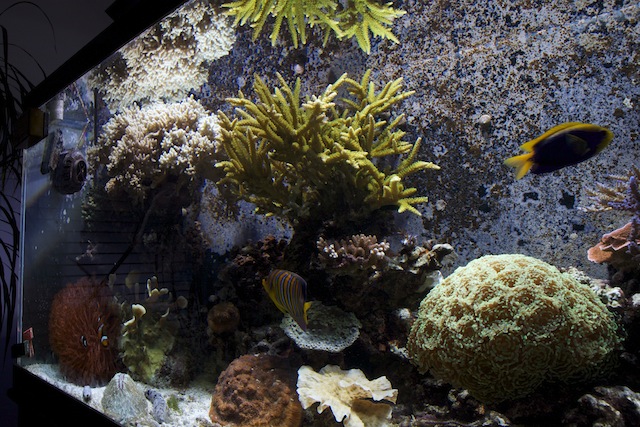Over the last few years, I migrated every reef tank I have to LED, even a little freshwater nano is running LED. I think there is a huge future in LEDs and switching to LED changed my view on lighting and brought on some serious thinking about our disposable consumerism. The longevity of LEDs makes throwing bulbs out on a yearly basis seem wasteful.
Things were humming along great; LPS were happy and sps were colorful and growth was good. But as frags grew into colonies, I noticed some interesting developments in my 180-gallon. My branching corals, like Acropora, developed recession in the shaded branches. And this led to gradual tissue recession. I found this quite interesting. The illuminated areas still grew like crazy and coloration was phenomenal.

I took a step back, and noticed this issue didn’t manifest in plating corals and other morphs. My brain started fixating on my LEDs. Branching staghorns are prone to self shading. It just happens. Meanwhile, LEDs are known for hard shadows, particularly systems that use highly directional lenses. All those little individual diodes are just like tiny point sources of light. And that creates a lot of shadows for the same reason LEDs produce a lot of glimmer lines.
The anecdotal tinkerer in me wanted to see what would happen if I put some halides back on. I pulled my old 3x 250-watt halide fixture out of the closet. The fixture also has a compliment of T5 Actinics. A few weeks later, the recession in the shadows ceased. The light clearly bathed the entire tank in light. Heck, it bathed the whole room in light(unfortunately) and the shadows were no more.
This revisit of metal halides modified my view regarding LEDs on large systems . I think I could have remedied the shading by adding more LED modules, but it gets to be very cost prohibitive on a large system. It is my personal feeling that many LED fixtures have some shortcomings on larger tanks, particularly if you go by the manufacturer recommended number of fixtures. I think LED recommendations are mostly based on measuring PAR values within a given area, like 2′ x2′.
While the different brands of LED certainly meet PAR requirements for that area with a single module or fixture, the nature of LEDs results in shadows from branching corals. As these corals grow larger, the shading starts to hinder or recede growth. I think the solutions is simple. As your tank gets larger, the distribution surface of the light fixture needs to get larger too.
I need to iterate, this isn’t the fixture’s fault, I’m blown away by LEDs but they do have some shortcomings. People need to recognize that sometimes more fixtures or modules are needed; NOT for PAR but better spread… The upside is you can start with less modules, and add more as the corals grow larger. The same can be said for flow pumps.
But can we make better LED fixtures?
It’s a ying yang situation. You could solve the excessive shading by spreading the placement of diodes out over a larger surface area, rather than a tight cluster with optics. The problem with this solution is that you end up with massive fixtures covering the majority of the tank, and also risk the disco effect of isolated colors on the corals and sand.
The better solution for larger tanks is hybrid fixtures. A mixture of old and new:
Hybrid 1: Keep the LEDs tightly clustered with optics, but throw in some T5. The LEDs would add a lot of PAR, while the tight cluster would create an attractive glimmer without disco colors. And the T5 provide a distributed light source to fill in any harsh shadows. Electricity and heat would still be in the efficient range.
Hybrid 2: Bring back the metal halides, but at lower wattages. Then supplement with a barrage of blue LED. The LEDs would replace the usual T5 Actinics. Heat would be greater with halides, but it would overall still be an efficient approach for larger tanks.
Hybrid fixtures are no stranger to this hobby. Reefkeepers have been mixing metal halides with VHO, T5, and even compact flourescents for decades. I want to add that my 70 gallon doesn’t have shading issues. The smaller surface area is effectively bathed by the LED fixture above it.

So where do I go from here? Am I sticking with halides for now? No, I hope not. The temperature in my reef was 78 with LED, and 82 with Halides. Electricity usage is higher than I want as well. And I hate how the halides bleed light into the room. The glare is annoying, since I don’t have a canopy. I’m also wondering if my issues would have been non-existent if I had grown my corals under LED from the beginning.
I miss the LED tremendously. Right now, I’m weighing my options. The easiest solution would be to add even more LED modules to my current arsenal of five. But I also like the idea of going hybrid on the 180-gallon. I’m intrigued by the hybrid ATI Powermodule fixture I keep seeing on the web. Hopefully, we see more of these types from other brands.
I’ll post an update when I make up my mind. Below you can see some old photos of the same reef aquarium under the metal halides and even after some time with a T5 fixture.





